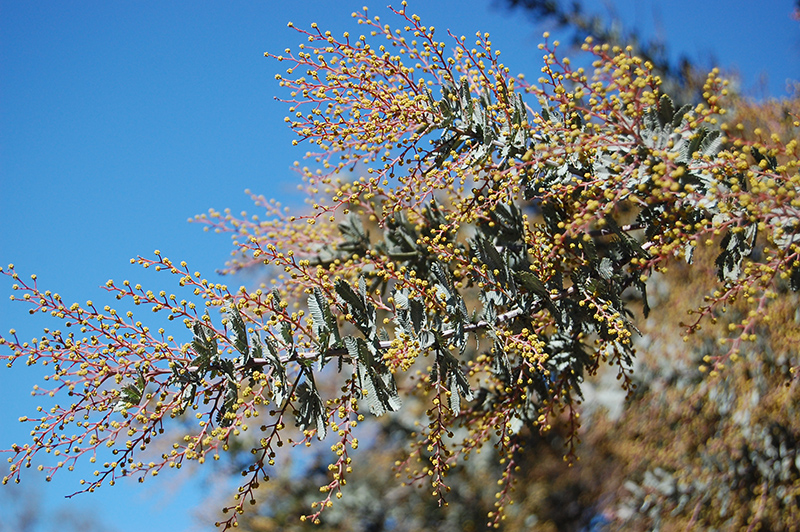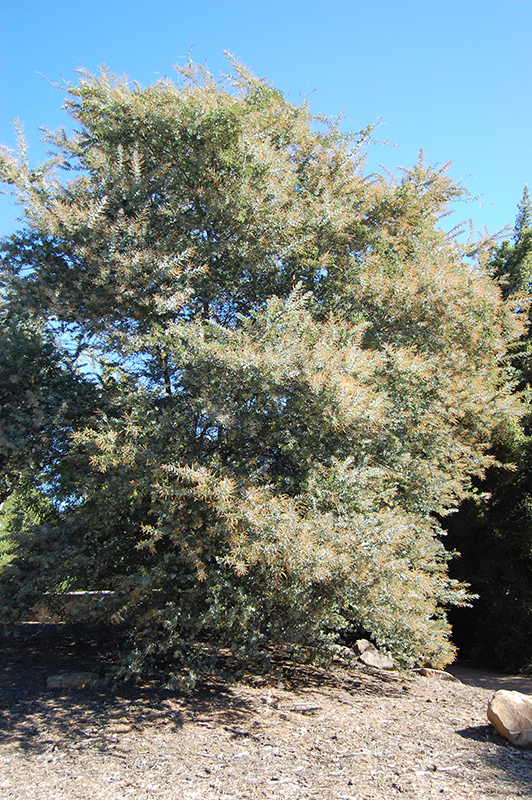Purple Fernleaf Acacia Acacia baileyana 'Purpurea' Height: 25 feet Spread: 25 feet
Sunlight:
Hardiness Zone: 9a Other Names: Cootamundra Wattle, Bailey's Acacia, Golden Mimosa Description: A large, graceful shrub or small tree with a wide spreading canopy; feathery, lavender-purple new foliage matures to blue-gray; fragrant pea-like, golden-yellow flowers appear in late winter to spring; drought tolerant once established Ornamental Features Purple Fernleaf Acacia features showy racemes of fragrant yellow ball-shaped flowers along the branches from late winter to early spring. It has attractive powder blue foliage with hints of silver which emerges purple in spring. The tiny narrow bipinnately compound leaves are highly ornamental and remain powder blue throughout the winter. The fruits are showy brown pods displayed from mid summer to mid fall. Landscape Attributes Purple Fernleaf Acacia is a multi-stemmed evergreen tree with a shapely form and gracefully arching branches. Its relatively fine texture sets it apart from other landscape plants with less refined foliage. This is a relatively low maintenance tree, and should only be pruned after flowering to avoid removing any of the current season's flowers. It is a good choice for attracting birds, bees and butterflies to your yard, but is not particularly attractive to deer who tend to leave it alone in favor of tastier treats. Gardeners should be aware of the following characteristic(s) that may warrant special consideration; Purple Fernleaf Acacia is recommended for the following landscape applications; Planting & Growing Purple Fernleaf Acacia will grow to be about 25 feet tall at maturity, with a spread of 25 feet. It has a low canopy with a typical clearance of 1 foot from the ground, and is suitable for planting under power lines. It grows at a fast rate, and under ideal conditions can be expected to live for approximately 30 years. This tree does best in full sun to partial shade. It does best in average to evenly moist conditions, but will not tolerate standing water. It is not particular as to soil pH, but grows best in sandy soils. It is somewhat tolerant of urban pollution. This is a selected variety of a species not originally from North America.; however, as a cultivated variety, be aware that it may be subject to certain restrictions or prohibitions on propagation.![]()
![]()
![]()
![]()
![]()
![]()
![]()
![]()
![]()
![]()
![]()
![]()
![]()
![]()
![]()
![]()
top of page
Louie's Nursery Menifee - Plant Finder
Characteristics
Applications
Features & Attributes
This tool is an online resource representing many of the varieties that we carry over the course of the season, and is intended for informational purposes only. Inventory varies seasonally, so we cannot guarantee that every plant will be in stock at all times - please contact the store directly for current availability. It does not include our entire selection of plants, so be sure to visit our store to see varieties that may not be represented on this list.
bottom of page


